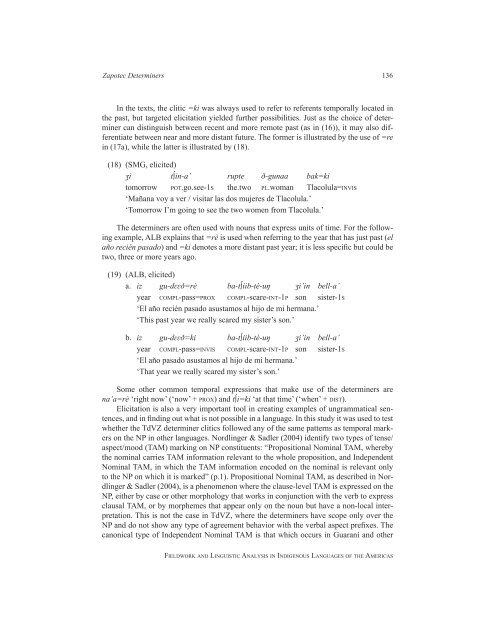Fieldwork and Linguistic Analysis in Indigenous ... - ScholarSpace
Fieldwork and Linguistic Analysis in Indigenous ... - ScholarSpace
Fieldwork and Linguistic Analysis in Indigenous ... - ScholarSpace
Create successful ePaper yourself
Turn your PDF publications into a flip-book with our unique Google optimized e-Paper software.
Zapotec Determ<strong>in</strong>ers 136<br />
In the texts, the clitic =ki was always used to refer to referents temporally located <strong>in</strong><br />
the past, but targeted elicitation yielded further possibilities. Just as the choice of determ<strong>in</strong>er<br />
can dist<strong>in</strong>guish between recent <strong>and</strong> more remote past (as <strong>in</strong> (16)), it may also differentiate<br />
between near <strong>and</strong> more distant future. The former is illustrated by the use of =re<br />
<strong>in</strong> (17a), while the latter is illustrated by (18).<br />
(18) (SMG, elicited)<br />
ʒi t∫<strong>in</strong>-a’ rupte ð-gunaa bak=ki<br />
tomorrow Pot.go.see-1s the.two Pl.woman Tlacolula=<strong>in</strong>vis<br />
‘Mañana voy a ver / visitar las dos mujeres de Tlacolula.’<br />
‘Tomorrow I’m go<strong>in</strong>g to see the two women from Tlacolula.’<br />
The determ<strong>in</strong>ers are often used with nouns that express units of time. For the follow<strong>in</strong>g<br />
example, ALB expla<strong>in</strong>s that =rè is used when referr<strong>in</strong>g to the year that has just past (el<br />
año recién pasado) <strong>and</strong> =ki denotes a more distant past year; it is less specific but could be<br />
two, three or more years ago.<br />
(19) (ALB, elicited)<br />
a. iz gu-dɛɛð=rè ba-t∫iib-tè-uŋ ʒi’<strong>in</strong> bell-a’<br />
year comPl-pass=Prox comPl-scare-<strong>in</strong>t-1P son sister-1s<br />
‘El año recién pasado asustamos al hijo de mi hermana.’<br />
‘This past year we really scared my sister’s son.’<br />
b. iz gu-dɛɛð=ki ba-t∫iib-tè-uŋ ʒi’<strong>in</strong> bell-a’<br />
year comPl-pass=<strong>in</strong>vis comPl-scare-<strong>in</strong>t-1P son sister-1s<br />
‘El año pasado asustamos al hijo de mi hermana.’<br />
‘That year we really scared my sister’s son.’<br />
Some other common temporal expressions that make use of the determ<strong>in</strong>ers are<br />
na’a=rè ‘right now’ (‘now’ + Prox) <strong>and</strong> t∫i=ki ‘at that time’ (‘when’ + dist).<br />
Elicitation is also a very important tool <strong>in</strong> creat<strong>in</strong>g examples of ungrammatical sentences,<br />
<strong>and</strong> <strong>in</strong> f<strong>in</strong>d<strong>in</strong>g out what is not possible <strong>in</strong> a language. In this study it was used to test<br />
whether the TdVZ determ<strong>in</strong>er clitics followed any of the same patterns as temporal markers<br />
on the NP <strong>in</strong> other languages. Nordl<strong>in</strong>ger & Sadler (2004) identify two types of tense/<br />
aspect/mood (TAM) mark<strong>in</strong>g on NP constituents: “Propositional Nom<strong>in</strong>al TAM, whereby<br />
the nom<strong>in</strong>al carries TAM <strong>in</strong>formation relevant to the whole proposition, <strong>and</strong> Independent<br />
Nom<strong>in</strong>al TAM, <strong>in</strong> which the TAM <strong>in</strong>formation encoded on the nom<strong>in</strong>al is relevant only<br />
to the NP on which it is marked” (p.1). Propositional Nom<strong>in</strong>al TAM, as described <strong>in</strong> Nordl<strong>in</strong>ger<br />
& Sadler (2004), is a phenomenon where the clause-level TAM is expressed on the<br />
NP, either by case or other morphology that works <strong>in</strong> conjunction with the verb to express<br />
clausal TAM, or by morphemes that appear only on the noun but have a non-local <strong>in</strong>terpretation.<br />
This is not the case <strong>in</strong> TdVZ, where the determ<strong>in</strong>ers have scope only over the<br />
NP <strong>and</strong> do not show any type of agreement behavior with the verbal aspect prefixes. The<br />
canonical type of Independent Nom<strong>in</strong>al TAM is that which occurs <strong>in</strong> Guaraní <strong>and</strong> other<br />
fieldwork <strong>and</strong> l<strong>in</strong>guistic analysis <strong>in</strong> <strong>in</strong>digenous languages of the americas

















